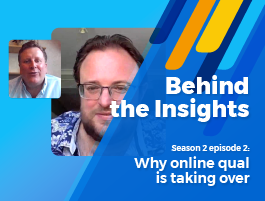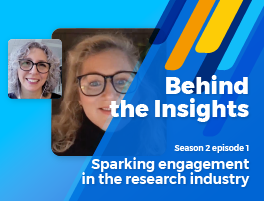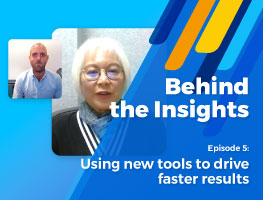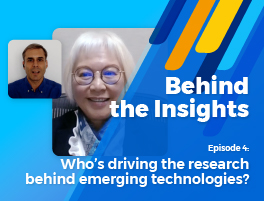Behind the Insights season 2 episode 3
Plenty of fish in the sea: Casting a wider net with social media data
This is Behind the Insights, a vodcast series by MetrixLab. We talk to experts from all over the world to find out what’s really driving today’s hottest topics in insights.
In this episode, join MetrixLab’s Global Social Insights Lead, Gilbert Saktoe, and Netbase Quid’s Senior Solutions Consultant, Jackie Balchin, as they dive into the importance of social data, its effectiveness, and how it can be optimized for your brand. Learn how combining social data with traditional research can yield even more granular insights. It might just be what your brand needs to succeed!
Check it out and stay tuned for more episodes every month!
Or if you prefer, read the full transcript below.
Intro: Welcome back to Behind the Insights, a vodcast Series by MetrixLab. We talk to experts from all over the world to find out what’s really driving today’s hottest topics in insights.
Gilbert: Hey, guys, I’m back. And look, my conversation partners, they’re always top-notch. The creme de la creme.
And today, I have the absolute pleasure to talk with Jackie, a very senior solution consultant in the social media world. And Jackie always has these brilliant thoughts and very bright ideas when it comes to social media research.
But I’m jumping the gun. Jackie, please introduce yourself.
Jackie: Hi, thank you for the lovely introduction. I always find that I get introduced better than the way I introduce myself. But, yeah, I’m Jackie, I’m from Netbase Quid. We’ve actually been working for the last four years together as partners. But I also have about just over ten years of experience in the industry, mainly in social listening and things like that. So, yeah, that’s me.
Gilbert: Thanks Jackie. And so we both work a lot with many different partners, and we often get questions from these partners around topics. For example, believe it or not, but sometimes we get feedback that the social media data stream is not needed, or at least is not a necessity, because our partners have other streams of data that they heavily rely on, such as survey data. What is your take on this?
Jackie: I think it’s interesting because, you know, when you think of a survey, you’re directing the question. So you have a focus on what you want to find out. And that’s great because it’s a good way to find out what you want to find out. But you’re missing other things that you may not be aware of that you need to find out.
You might not be aware of the fact that there are complaints about a certain product or that they don’t like that you haven’t done something yet or you have done something and they don’t like it. So I think it’s interesting to hear that people are still not necessarily viewing social data as another important part of their research because it’s unbiased, you know, it’s free conversation. It’s like sitting at a coffee shop and hearing someone talking about your brand and you just kind of eavesdrop to find out what they’re saying. It’s exactly that.
So, you can still focus it because you can still say, OK, if someone’s talking about this product, someone’s talking about that, then you can still focus it. But the discovery aspect of it is much broader because you know, you’re not directing any questions. It’s completely “let’s read what people are saying about us.” And it’s unlimited in a way because people can just write what they want.
And reason why I think there’s this misconception that maybe they don’t need the social data is probably because they still think of social as your Twitter, your Facebook, your Instagram. And if you think of those channels, especially Twitter, it’s a very limited word count but when I think of social media, it’s forums, it’s blogs, and there’s much richer data in there that you can go into and find out about your brand or your product or your survey.
Gilbert: Yeah. And to build on that, you also believe that social is an excellent complement to any kind of research that’s out there, whatever it is, quant or qual. And you can triangulate the different findings from the different sources. And this could make a marketeer more comfortable when they make certain decisions. So, it also gives a richer picture of findings or insights because those different methods could also inform each other.
To give you an example, in a survey metric in the performance of a luxury car in America, we saw that the design was the key reason for the drop off of the performance. So we leveraged social to investigate this further. And it turns out that people that didn’t like the plastic material they used in the dashboards because it gave them less of a luxury feeling.
So that’s what I mean with the different methods in informing each other.
Jackie: Yeah, that’s exactly it. Like you might find something in a survey. And I like that you talk about them marrying up or combining together because you know, you can always just use one, but they work best when it’s together and you get more granular detail.
You know, there’s the word clouds. There are the sentiment drivers. There are all these things that you can look at like reading the caption, reading, and understanding and it’s that extra level of detail that can direct your focus.
Like why that design? Like, OK, design, but design what? And then you can find that other detail on a forum or a tweet or anything like that.
Gilbert: So Jackie, it’s kind of a sensitive topic. But fortunately it is also less often these days, but still, market theorists, they are still questioning the validity of social media data because they believe it’s not always representative of the entire population. So, again, I’m very curious to hear your thoughts about this.
Jackie: Yeah. So I do have an interesting take on it because, again, we can’t say that a survey is representative. In fact, again, I love surveys, but I feel like I come across as I don’t. But, you know, there is a much smaller volume of data on surveys than it would be on social media. So I always find that an interesting point when someone comes up to me at a conference or a client says that to me on the phone, I always find that interesting.
And one thing that I remember saying before when we talked about it, you know, you look at the commercials, the adverts from a beauty brand. I always noticed that in beauty, but I’m sure it’s other brands and a lot of other industries. They’ll say this product was tested. And 90% of women or meagree that they made their skin clearer or whatever it was that the product was meant to do. But I always read that little line of the bottom and it’s very, very, very small. And it will say 150 people were surveyed. And again, in those 150 they might have had different ethnicities, different genders, different ages. So it’s fine, but it’s still a very small pool of people.
So I do always find that interesting as a rebuttal when people say that social media data are not representative because actually you can have a pool of people that could be maybe 200 people on survey versus literally thousands of people on social media. And I think actually you get an even better representation because everyone well, I don’t want to generalize, but most people have access to social, whether it’s your client or not.
And you want the feedback from people that don’t buy your product, like why are they not buying it? They’re not going to come and do your survey if they’re not your customer. But you might get responses. Like someone saying “Oh, I prefer Pizza Express versus Domino’s” and then they don’t buy Domino’s. But now you find out why they prefer Pizza Express because maybe it’s fresher, but you won’t get that in your survey.
So anyway, I can talk about it forever, but I get that question a lot as well. And it always puzzled me, if I’m honest.
Gilbert: Yeah. It’s very bold, but I dare to say that social is actually, in certain categories and certain countries, much more representative. And we investigated this in certain financial services in Europe, and we found that the demographics really matched their target audience. So I think it could be very representative. It’s even more representative if you combine it with all these customers.
Jackie: Yeah, so maybe the reason why people think that as well is, again, when I think social media, it tends to be like your social media networks but actually when we talk about social media, it’s media that’s social. So it’s forums as well.
We get a lot of conversations from patients. You know, it’s not necessarily about very critical illnesses, but, you know, illnesses that are a little bit more talked about in the space. We find conversations about patients talking to each other, advising others, etc. Again, you’re not going to get that anywhere else. And there’s a lot of like petrol heads, you know, like car fanatics on the socials and on forums, moms that are talking to each other about things for their kids.
So yeah, I think maybe that’s also why people think about social media a certain way. They don’t tend to think that it also can involve forums and things like that.
Maybe I found the reason why.
Gilbert: Yeah, I love those examples that you gave. Maybe one final note on this is that even though not everybody is posting a review, but a lot of people are still reading those reviews, so they get influenced by those conversations.
Jackie: Yeah.
Gilbert: The conversations might not come from every age group, demographic, gender, etc but it could impact anybody who has access to the Internet as well.
So one other note right, one other thing that I often hear from clients is about the ROI or the return on investment. I see that not everybody still sees the value in investing in social media data. Do you have any thoughts on this?
Jackie: Yeah, I see that less, which is good. I think the reason why it is like this is because it is a lot less tangible. So there’s not like “Oh, I’ve done this promotion and I’ve tracked a link and then people bought it.” Like there isn’t something that you can tangibly assess.
So I think, that’s why there’s a bit of a well, “what’s the ROI?” But then at the same time, you know, if you, for example, have clients that notice certain things like we had, we work with a big beauty client, and they noticed something on their Instagram page actually. But they get thousands of comments. So, you know, it’s hard to read them all, but having a tool that can read them and contextualize it in word clouds helped them. They started seeing things like leaks or breaking, and it was a fairly luxury product, like a serum. And the cap for some reason was not closing properly. So they knew that within a day, within a couple of hours of people posting it.
Obviously you get a couple and you think, well, maybe it’s just they didn’t close it properly or a one off. But then it started to grow where people started saying “Oh, yeah, mine too. It went all over my handbag” and straight away, they’re like, “OK, there’s something wrong with this serum bottle. We need to change it.” And so, to me, that’s ROI because now you’re going to have less unsatisfied customers.
We have loads of examples of that. You know, there’s people that are changing caps. I think I mentioned it to you a while ago, like this is not our client, but this is something that I’ve heard from another presenter in the past. But apparently Colgate was using social data and they found out that people were always losing the screw top and that was something that they noticed from social chatter. And then now they’ve changed it so that it’s a cap rather than an actual screw top.
So again, that’s not ROI because they’re still selling the same amount of toothpaste probably because it’s a product that everyone has to buy. But again, you have more happy customers. If there was another brand that thought of doing the cap before you, customers would have switched and then you would have lost them. So it’s more about how can the social data married up with survey create that better customer experience?
Especially now, even if you’re a big market leader in this world, people are not loyal the way they used to be. They switch from brand to brand. They might prefer going for an indie brand so having those nuggets of how to improve the product and the customer experience will just retain the customer more.
Gilbert: Gotcha. Yeah. On top of that you have these brilliant researchers like Professor Gerard Tellis or Sonja Gensler, and they have done several studies, linking user generated content reviews and social media publications to sales or business performance and even stock prices. So in some cases, those relationships are established to the returns. And we also did some similar studies where we investigated the predictive value of social media on sales of units sold. And again, we were able to establish that. But I love those examples that you gave because suppose there is a new flavor of ice cream and that conversation comes from just one person, say it’s the Heisenberg flavored ice cream. And if somebody commercializes it and it becomes a big success, then I think a lot of people will be happy about those returns for that ice cream.
Jackie: Yeah. So that’s the thing, I like that you say predictive because I always talk about purchase funnel social signals, we do this a lot like when a brand new car launches
and people are saying, “oh, I want to buy it.” Or they’re saying, “I want to switch from the main competitor to this one now.” So we always work with clients on these predictive, I always call them social signals, like the purchase funnel social signals, because you could create a system where there’s higher growth or people saying, “I love this” or “I need to buy it” or “I need to switch.” And then notice if that correlates with your sales data.
So you could then see if you launch a new product or just a new campaign whether that is going to improve your…, if you don’t get that lift you could say “Sales? it’s just not going to go”
and you could start creating these models that you kind of work side by side.
So yeah, I guess if that was one of the things that I’d say is don’t look at it in silo, you’ve got to make sense with the rest of the business.
Gilbert: Gotcha, so more and more clients or partners, they’re discovering the power of
of leveraging A.I. in their research like getting real time results or reducing biases in our research. So will A.I. take over from humans?
Jackie: I personally don’t think so. I think you still need that human touch as much as companies and vendors like us do. We are accurate with our sentiment. We can detect emotions, we can detect behaviors. You know, it’s really, really powerful. I’m always shocked that we can detect sarcasm and things like that. But there’s still that human interpretation that you’ve got to add in and then obviously A.I. can’t interpret what to do next.
I mean, maybe one day it will, maybe one day it will say “do this”. But I do still think there is a human touch because again, like, the culture doesn’t always get considered. You know, when we analyze and I’m going to say something very stereotypical because I guess I can say I’m half-Italian, but, you know, if you think of the Italian language it’s passionate, it’s very like you know, you can see from my hands and then if you think maybe of the English language, so I can say that again because I’m half English, it’s a little bit less passionate. It’s a bit, you know, steady.
And so if you’re looking at passion, sentiment and things like that, you’re going to get higher passion in Italian and then maybe less in English. Again, not stereotypical, but kind of you got to think of cultures, and I don’t see that happening in A.I. yet, you know, seeing that kind of representation of cultures. And I don’t even know how you would really add that in. But yeah, so you’ve got to contextualize it with what’s going on in the world.
You know, everyone’s moaning about high energy prices, but then if you weren’t contextualizing with what’s going on in the world, you would say, “Hey, energy companies, you’re in trouble. Everyone doesn’t like you.” Well, they’re not in trouble. They’re fine. So you’ve got to contextualize, you know, the culture, the past, the political, economical, social, aspects of what’s going on in the world.
So no I don’t think it will. But you never know.
Gilbert: You never know. And so, Jackie, maybe one final question, right? So you work with a lot of clients, a lot of awesome clients. So what kind of changes do you see in how people use social data in the past couple of years?
Jackie: Yeah, that’s a really good question. And it kind of fits in with what we were talking about surveys. What I’m seeing is that we’re finally breaking down the silos. Teams are talking to each other a lot more that they might have data that helps each other, but also there’s more infrastructure to bring the data together, you know, your tableaus, your other power BI that you may have like, you know, things like that.
So a lot of data is getting merged together. People are beginning to add in their own statistical models. Like I said before, modeling the sales with predictive social signals, modeling whether or not something is going to be a trend or a fad, adding in social, but then also adding insight. You know, like there’s a lot more merge of data now, which is nice to see because I think like you said, at the beginning, to create that full picture, you can’t just rely on one data source. Even though that data source, like social is a lot of volume you still should add in your own surveys, your focus groups and so on. So yeah, I’m seeing a lot more of that.
Gilbert: Gotcha. Yeah. And similarly, you know, indeed a lot of our clients, they’re just building a lot of data. But the feedback that we also see these days is that they’re drowning in the data. Like there is so much data out there.
Jackie: Yeah.
Gilbert: And their need is growing around actionability like what to do with the data. How does it help me in my decision making? I think, you know, with the help of A.I., that definitely helps with also again, you need that human sense making to help with that actionability.
Jackie: Yeah
Gilbert: Jackie, thanks again for illuminating my mind. Thanks for having this chat with me.
Jackie: No, thank you so much for having me. And yeah, hopefully we’ll speak again
soon about this.
Gilbert: Hopefully, yes








